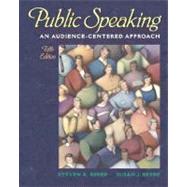
Chapter 1. Introduction to Public Speaking.
Why Study Public Speaking?
Public Speaking and Conversation.
The Communication Process.
The Rich Heritage of Public Speaking.
Public Speaking and Diversity.
Speaker's Homepage: The Power of the Internet.
Chapter 2. Overview of the Speechmaking Process.
Improving Your Confidence as a Speaker.
Speaker's Homepage: Tips for Managing Your Communication Apprehension.
Preparing Your First Speech: An Overview of the Speechmaking Process.
Sample First Speech: Can You Read My Mind?, by Christopher Therit.
Chapter 3. Ethics and Free Speech.
Speaking Freely.
Speaking Ethically.
Speaker's Homepage: Ethics and Free Speech.
Listening Ethically.
Chapter 4. Listening.
Barriers to Effective Listening.
Becoming a Better Listener.
Improving Your Note-Taking Skills.
Listening and Critical Thinking.
Speaker's Homepage: Practicing Your Critical Listening Skills.
Analyzing and Evaluating Speeches.
Chapter 5. Analyzing Your Audience.
Becoming an Audience-Centered Speaker.
Analyzing Your Audience Before You Speak.
Speaker's Homepage: Gathering Information About Your Audience.
Adapting to Your Audience as You Speak.
Analyzing Your Audience After You Speak.
Chapter 6. Developing Your Speech.
Select and Narrow Your Topic.
Speaker's Homepage: Using the Web to Prime Your Creative Pump for a Speech Topic.
Determine Your Purpose.
Develop Your Central Idea.
Generate and Preview Your Main Ideas.
Meanwhile, Back at the Computer…
Chapter 7. Gathering Supporting Materials.
Personal Knowledge and Experience.
The Internet.
Speaker's Homepage: Evaluating Websites.
Library Resources.
Interviews.
Resources from Special-Interest Groups and Organizations.
Research Strategies.
Chapter 8. Supporting Your Speech.
Illustrations.
Descriptions and Explanations.
Definitions.
Analogies.
Statistics.
Opinions.
Speaker's Homepage: Using the Internet to Find Interesting Supporting Material.
Selecting the Best Supporting Material.
Chapter 9. Organizing Your Speech.
Organizing Your Main Ideas.
Speaker's Homepage: Internet Resources to Help You Organize Your Speech.
Subdividing Your Main Ideas.
Integrating Your Supporting Material.
Organizing Your Supporting Material.
Developing Signposts.
Supplementing Signposts with Visual Aids.
Chapter 10. Introducing and Concluding Your Speech.
Purposes of Introductions.
Effective Introductions.
Speaker's Homepage: Using the Web to Find an Attention-Catching Introduction.
Purposes of Conclusions.
Effective Conclusions.
Inspirational Appeals or Challenges.
Chapter 11. Outlining Your Speech.
Preparation Outline.
Speaker's Homepage: Using Internet Resources to Improve Your Outlining Skill.
Delivery Outline.
Chapter 12. Using Words Well: Speaker Language and Style.
Oral versus Written Language Style.
Using Words Effectively.
Adapting Your Language Style to Diverse Listeners.
Crafting Memorable Word Structures.
Speaker's Homepage: Using Internet Resources to Polish Your Spoken Prose.
Tips for Using Language Effectively.
Chapter 13. Delivering Your Speech.
The Power of Speech Delivery.
Methods of Delivery.
Characteristics of Effective Delivery.
Audience Diversity and Delivery.
Speaker's Homepage: Evaluating Speaker Delivery.
Rehearsing Your Speech: Some Final Tips.
Delivering Your Speech.
Adapting Your Speech Delivery for Television.
Chapter 14. Using Presentation Aids.
The Value of Presentation Aids.
Types of Presentation Aids.
Guidelines for Developing Presentation Aids.
Speaker's Homepage: Using the Internet as a Source for Visuals for Your Speech.
Guidelines for Using Presentation Aids.
Chapter 15. Speaking to Inform.
Goals of Informative Speaking.
Types of Informative Speeches.
Strategies to Enhance Audience Understanding.
Speaker's Homepage: Finding Late-Breaking News and Information for Your Speech.
Strategies to Enhance Audience Interest.
Strategies to Enhance Audience Recall.
Informative Speech: Brain Fingerprinting, by Chad Crowson.
Chapter 16. Principles of Persuasive Speaking.
Persuasion Defined.
How to Motivate Listeners.
How to Develop Your Persuasive Speech.
Putting Persuasive Principles into Practice.
Speaker's Homepage: Finding Out About Congressional Legislation for Persuasive Speeches.
Chapter 17. Using Persuasive Strategies.
Establishing Credibility.
Enhancing Your Credibility.
Using Logic and Evidence to Persuade.
Using Emotion to Persuade.
Speaker's Homepage: Information Triage—Identifying Reasoning Fallacies.
Strategies for Adapting Ideas to People and People to Ideas.
Strategies for Organizing Persuasive Messages.
Persuasive Speech: Genetic Discrimination, by Steve Zammit.
Chapter 18. Special-Occasion Speaking.
Public Speaking in the Workplace.
Ceremonial Speaking.
Speaker's Homepage: A Toast to You and Yours: Tips for Making Toasts.
After-Dinner Speaking.
Chapter 19. Speaking in Small Groups.
Solving Problems in Groups and Teams.
Tips for Participating in Small Groups.
Using the Power of Technology in Groups.
Leadership in Small Groups.
Managing Meetings.
Speaker's Homepage: Using Parliamentary Procedures to Give Structure to Large Groups.
Presenting Group Recommendations.
Tips for Planning a Group Presentation.
Tips for Making a Group Presentation.
Epilogue.
Appendix A: The Classical Tradition of Rhetoric.
Appendix B: Suggested Speech Topics.
Appendix C: Speeches for Analysis and Discussion.
Martin Luther King, Jr., I Have a Dream.
Cynthia Opheim, Making Democracy Work: Your Responsibility to Society.
Sarah Root, Antibiotic Resistant Bacteria.
Kittie Grace, Unsanitary Hotels.
Jimmy Ficaro, The Cost of Out Conscience: Changing Patent Laws for Overpriced Prescription Drugs.
Karon Bowers, Schadenfreude.
Notes.
The New copy of this book will include any supplemental materials advertised. Please check the title of the book to determine if it should include any access cards, study guides, lab manuals, CDs, etc.
The Used, Rental and eBook copies of this book are not guaranteed to include any supplemental materials. Typically, only the book itself is included. This is true even if the title states it includes any access cards, study guides, lab manuals, CDs, etc.